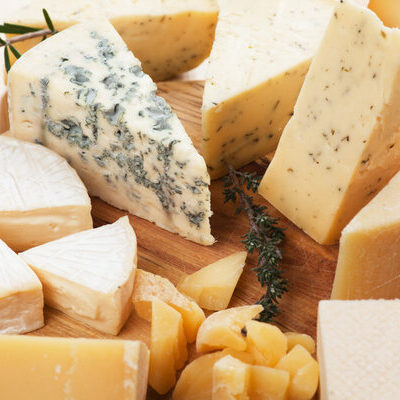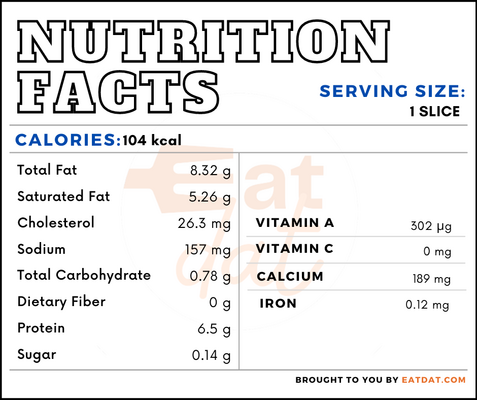
Cheese
What is Cheese?
Cheese is a dairy product made from milk through the coagulation of the casein protein. It may be made using milk from various animals including cows, buffaloes, goats, sheep, camels, horses, and even yak. Depending on the type, it may have different flavors, including mild, pungent, milky, salty, creamy, or moldy.
- Most varieties range between chalk white to deep yellow in color, but there are some unique varieties as well, including the green cherni vit (Bulgaria), blue cheese (France), and even pink Wensleydale (England).
- There are thousands of types of this dairy product around the world.
The top 10 most popular types of cheese include:
- Camembert (France)
- Gorgonzola (Italy)
- Paneer (India)
- Brie (France)
- Gouda (Netherlands)
- Parmigiano Reggiano (Italy)
- Ricotta (Italy)
- Feta (Greece)
- Cheddar (England)
- Mozzarella (Italy)
Origin of cheese
Production dates back over 4,000 years ago. Legend has it that it was an accidental discovery. An Arab trader was travelling and kept some milk in sheepskin. The heat and the rennet in the skin converted the milk into cheese. The earliest records are from Ancient Egyptian murals, in which the food is depicted. From Asia, this dairy product traveled to Europe, where it became extremely popular in the Roman Empire. Later on, it spread throughout Europe and was introduced into the Americas by European colonizers.
Nutrition
Nutritional profile for cheese (1 slice):

Cheese is rich in calcium, phosphorus, sodium, and vitamin A. Also, it contains magnesium, potassium, selenium, folate, choline, retinol, carotene, vitamin D, and fatty acids in decent quantities. Regular consumption of this dairy product may help in combating inflammation, preventing osteoporosis and arthritis, decreasing the risk of fractures, and managing obesity. As a good source of vitamins and minerals, this nutrient-dense food is an excellent addition to any diet.
Commercial production
The largest cheese producing countries are the USA, Germany, France, Italy, the Netherlands, Poland, Russia, Egypt, Czech Republic, Argentina, and the UK. Cheese is produced from milk with the help of coagulants. Traditionally, this used to be rennin, but other acids are used nowadays. Other flavorings such as herbs, spices, or salt may be added to the product to enhance flavor.
First, the milk is processed and the rennin or other enzymes are added to it, allowing it to ferment and curdling it. Then, the curds and whey begin separating and the curds are then cut once they form a whole mass. Once cut, it is stirred and cooked further until the whey is completely separated, after which it is drained away. In some cheeses, it undergoes further de-moisturization through a process called cheddaring, stacking pieces of curd on top of each other. The salt and other flavors are added at the very end, after which the curds are molded into desired shapes. The final and most important step which makes the cheese what it is, is aging, the period of which differs for every variety.
Cheese ecipes
This is a versatile food that may be used for multiple purposes. It can be the main ingredient in a dish, like quesadillas, or a delicious topping in the case of pizza. Additionally, it can be used in both sweet and savory dishes. Here are a few recipes to try:
- Baked Pasta
- Italian Casserole
- Gougères
- Croque-Monsieur
- Tartiflette
- Käsespätzle
- Chilli Paneer
- Braaibroodjie
- Shakshuka
- Kanafa
- Fatayer
- Quesadilla
- Papa a la Huancaína
- Chorizo con Patatas y Queso
- Toastie
FDA regulations
The FDA offers standards of identity for many different popular types of cheeses.
References
Thorning, Tanja Kongerslev et al. “Milk and dairy products: good or bad for human health? An assessment of the totality of scientific evidence.” Food & nutrition research vol. 60 32527. 22 Nov. 2016, doi:10.3402/fnr.v60.32527, https://www.ncbi.nlm.nih.gov/pmc/articles/PMC5122229/
Dekker, Louise H et al. “Cheese and Healthy Diet: Associations With Incident Cardio-Metabolic Diseases and All-Cause Mortality in the General Population.” Frontiers in nutrition vol. 6 185. 17 Dec. 2019, doi:10.3389/fnut.2019.00185, https://www.ncbi.nlm.nih.gov/pmc/articles/PMC6927928/
Rozenberg, Serge et al. “Effects of Dairy Products Consumption on Health: Benefits and Beliefs–A Commentary from the Belgian Bone Club and the European Society for Clinical and Economic Aspects of Osteoporosis, Osteoarthritis and Musculoskeletal Diseases.” Calcified tissue international vol. 98,1 (2016): 1-17. doi:10.1007/s00223-015-0062-x, https://www.ncbi.nlm.nih.gov/pmc/articles/PMC4703621/2
